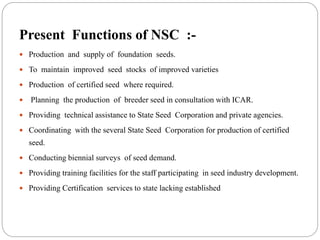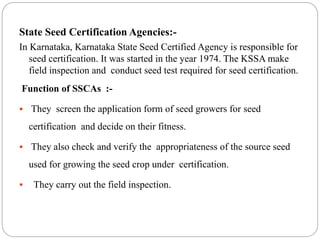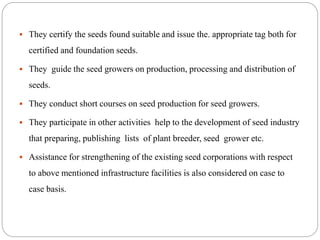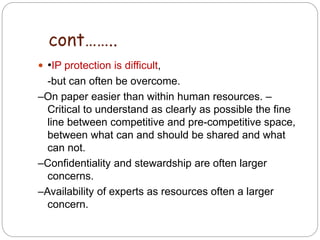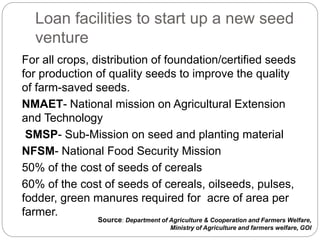Seed relationship
- 2. CONTENTS • Indian seed industry • Seed producing agencies: NSC, SSC • Private seed companies • Organisation in seed production • Policies favoring seed industry • PPP model in seed business • Export data of Indian seed • Loan facilities buy GOI, subsidies • Case study • Question and Answer
- 3. Indian Seed Industry Indian seed market is one of the largest seed market, dominated by open pollinated seeds. Hybridization gaining pace There are around 400 private players & 14 Government organizations Indian seed sector contribute to 16% GDP and also 10% in export earnings.
- 4. Indian Seed market •Total Seed Industry is worth about 3 -3.5 USD Bn • Cereal industry is worth 6000 crore approximately • About 1/3rd is contributed by cotton worth 2000crores • Rice OP and hybrids contribute about 1000 crores • Millet hybrids contribute 500 Crore • Corn contributes around 800 crore • Vegetable seed industry is worth 1500 crore
- 5. THE WORLD SEED MARKET (billions $) Total Seed Field Seeds Vegetable Flower Commercial Seeds 15 15 15 33% 33% 0 5 10 15 20 25 30 35 40 45 50 50 Billion Including Farmers Saved Seed Total Seed Field Seeds Vegetable Flower Commercial seed market 6.8 b$ Vegetable Seed 27.2 b $ Cereal Seed 20% vegetable seed 80% Field & other seed 34 Billion
- 10. Current facts of seed industry The Global Seeds Market accounted for $26.2 billion in 2015 and is poised to reach $55.3 billion by 2022 growing at a CAGR of 11.2% from 2015 to 2022. As per World Seed Trade Statistics, India has sixth largest size of domestic seed market in the world, estimated to be at about 1300 million dollars. India’s share in global trade in seeds (import & export) is of only about 37 million dollars.
- 11. Seed Export / Import The export/import of seeds and planting material is governed by the Export and Import ( EXIM) Policy 2002-07) Restrictions on export of all cultivated varieties of seeds have been removed w.e.f. 01.04.2002, except the following: (i) breeder or foundation or wild varieties; (ii) onion, cashew, rubber, pepper cuttings, sandalwood, saffron, neem, forestry species and wild ornamental plants; (iii) export of niger which is canalized through TRIFED, NAFED, etc. (iv) groundnuts, exports of which is subject to compulsory registration of contract with APEDA
- 12. The EXIM Policy reiterates that all imports of seeds and planting material would be regulated under the Plant Quarantine Order 2003. Import licences would be granted by DGFT only on the recommendations of DAC. A small quantity of seeds sought to be imported would be given to ICAR, or farms accredited by ICAR, for trial and evaluation for one crop season. Source: ISF compilation based on official statistics and international seed trade reports
- 13. Indian Export data: 2014-15 and 2015- 16 During 2015-16 stood at Rs. 493.54 crores. Bangladesh, Pakistan, United States, Netherland, and Japan were the major markets of India’s fruits and vegetable seeds. Quantity (Metric Tonnes),2014- 15 Value (USD Million), 2014- 15 Vegetable crops 5,709 Vegetable crops 44 Flower seed 175 Flower seed 2 Field crops 23,310 Field crops 30 Total 29,194 Total 76 Source: ISF compilation based on official statistics and international seed trade reports
- 14. India Seed Market Outlook to FY’2020 Source: Report of “India Seed Market Outlook to FY’2020 – Rapid Hybridization and Increased Government Support to Foster Future Growth”
- 15. SEED PRODUCTION AGENCY There are three type of Seed Production Agency. 1) Public sector. 2) Private sector
- 16. National Seed Production Agencies :- National seed corporation. (NSC) State Farm Corporation of India. (SFC) Indian Councils of Agriculture Research. (ICAR) Indian Institute of Horticulture Research. (IIHR) India Agriculture Research Institute. (IARI)
- 17. State Seed Production Agencies :- State Seed Production. (SSC) State Seed Certification Agency. (SSCA) Private Seed Companies. Global Players Domestic Players Nuziveedu Seeds Rasi Seeds Mahyco Seeds Ajeet seeds Monsanto India Kaveri seeds DuPont Pioneer Nirmal seeds
- 18. National Seed Corporation :- (NSC) It was initiated in 1961 under the Indian Council of Agriculture Research. Later on 7 March 1963 it was registered as a limited that is National Seed Corporation limited. And started functioning from July 1963. Objective of NSC:- 1)To promote the development of seed industry in India. 2)To produce and supply the foundation seeds of various crops. 3)Now a day its started production of breeder seed also.
- 19. Present Functions of NSC :- Production and supply of foundation seeds. To maintain improved seed stocks of improved varieties Production of certified seed where required. Planning the production of breeder seed in consultation with ICAR. Providing technical assistance to State Seed Corporation and private agencies. Coordinating with the several State Seed Corporation for production of certified seed. Conducting biennial surveys of seed demand. Providing training facilities for the staff participating in seed industry development. Providing Certification services to state lacking established
- 20. State Seed corporation :- First Tarai development corporation (TDC) was started at Pantnagar (U P). In karnataka Karnataka State Seed Corporation started in 1976. The main function of the KSSC. 1) Production and supply of foundation seed certification seed of notified kind/variety 2) With in the State marketing of seeds.
- 21. State Seed Certification Agencies:- In Karnataka, Karnataka State Seed Certified Agency is responsible for seed certification. It was started in the year 1974. The KSSA make field inspection and conduct seed test required for seed certification. Function of SSCAs :- They screen the application form of seed growers for seed certification and decide on their fitness. They also check and verify the appropriateness of the source seed used for growing the seed crop under certification. They carry out the field inspection.
- 22. They certify the seeds found suitable and issue the. appropriate tag both for certified and foundation seeds. They guide the seed growers on production, processing and distribution of seeds. They conduct short courses on seed production for seed growers. They participate in other activities help to the development of seed industry that preparing, publishing lists of plant breeder, seed grower etc. Assistance for strengthening of the existing seed corporations with respect to above mentioned infrastructure facilities is also considered on case to case basis.
- 23. Each State has a State Seed Certification Board which supervisor the activities of SSCA. In addition, there is a Central Seed Certification Board (CSCB) which adviser the State Govt and their SSCAS on the maters of seed certification. The chairman of this board is nominated by central Govt.
- 24. Private Seed Companies :- 1969, A number of private seed company are also engaged in seed production. Top 10 seed companies of India 2015-2016 • Nuziveedu Seeds • Agriquest • Rasi Seeds • Mahyco • National Seeds Corporations LTD • Kaveri Seeds • Krishi Jagran • JK Seeds • Nirmal Seeds India • National Seed Association of India: NSAI
- 25. Organization for Seed Production :- For breeder seed production :- ICAR, SAUS, IIHR, there are 33 breeder seed purity located in Agriculture University and Institute which has been established under National Seed Programm. Breeder seed supplied to govt agencies including the NSC,SSC, SFCI and reputed private seed companies. Foundation seed SAU, NSC, SFCI, SSC, and private seed company its certified by seed certified agency. Certified seed NSC, SFCI, SSC, and private seed company.
- 26. Policy Initiatives in Seed Sector: • Enactment of the Seeds Act, 1966 • Seed Review Team-SRT (1968) • National Commission on Agriculture’s Seed Group (1972) • Launching of the World Bank aided National Seeds Programme (1975-85) in three phases leading to the creation of State Seeds Corporations, State Seed Certification Agencies, State Seed Testing Laboratories, Breeder Seed Programmes. • Seed Control Order (1983) • Creation of the Technology Mission on Oilseeds & Pulses (TMOP) in 1986 now called, The Integrated Scheme of Oilseeds, Pulses, Oil Palm and Maize (ISOPOM).
- 27. New Seed policy :- 1988 Librize the import and export of seed policies GOI announce the New Seed Policy's. Objective :- 1)Liberize the import of high quality seed includes Agriculture as well as Horticulture produce. 2)A time bond programme to strengthening the plant quarantine measure especially for post entry quarantine. (PEQ) 3) Insentives to encourage the domastic seed Industries. 4)To encourage the export of seed.
- 28. Production and Distribution Subsidy • Distribution of Seed Mini-kits • Seed Transport Subsidy Scheme (1987) • New Policy on Seed Development (1988) • Seed Bank Scheme (2000) • National Seeds Policy (2002) • The Seeds Bill (2004) • Formulation of National Seed Plan (2005) • National Food Security Mission (2007)
- 29. National Seeds Policy, 2002: Thrust Areas • Variety development • Plant variety protection • Seed production • Quality assurance • Seed distribution and marketing • Infrastructure facilities • Transgenic plant varieties • Import of seeds and planting materials • Seed exports • Promotion of domestic private sector seed industry • Strengthening of the monitoring system
- 30. Seeds Bill, 2004: Salient Features • Registration of kinds and varieties of Seeds etc. – Evaluation of performance – Compensation to Framers – Registration of Seed Producers and Processing Units – Seed dealers to be Registered • Regulation of Sale of Seed and Seed Certification • Seed Analysis and Seed Testing • Export and Import of Seeds and Planting Material • Offences and Punishment.
- 31. Rashtriya Krishi Vikas Yojna, Macro Management Agriculture, Integrated Scheme for oilseeds, pulses, oil palm and maize (ISOPOM); Technology missions for cotton, National food security Mission etc. provide for subsidized seeds. New Policy on Seed Development (NPSD) includes permitting 100 per cent foreign direct investment (FDI) under the automatic route. The thrust is also on creating a seed bank.
- 32. Periodic trends in seed industry growth 3 2 Year Favours Domination Key Growth drivers 1963- 1983 Establishment of NSC marking a beginning of formal seed sector in India (1963),Seeds Act 1966 Public Sector Green Revolution ,launch of govt schemes like National Seed Project 1984- 1994 The liberalisation of seed policy in the form of New Policy on Seed Development (NPSD) in 1988 Entry of private domestic and multinational seed companies & investment in research and development, 50-60% pvt contribution The rapid growth of innovations (improved varieties, hybrids and proprietary technologies) and seed markets 1995- 2005 Strengthening of IPRs coupled with liberalised seed policies Private Sector (80- 90%) Bt cotton, single-cross maize hybrids, hybrid rice, vegetables , strengthening of IPRs coupled with liberalised seed policies 2006- 2015 2015- Favorable regulatory environs ,Government policies to promote investment in seed R&D and infrastructure. Access to international Markets. Improvement in SRR Private/Public Technological breakthroughs, Collaborations,Breeding for climate change,New Biotech traits
- 33. 3 3 Indian Seed Industry Value The private sector is playing a vital role. The number of companies engaged in seed production or seed trade is of the order of 400 or 500. 5200 6000 7500 9000 10500 12000 13500 2008 2009 2010 2011 2012 2013 2014 Value in Crores Value in Crores
- 35. A public-private partnership is a contractual agreement between a public agency (federal, state or local) and a private sector entity. Through this agreement, skills and assets of each sector (public and private) are shared in delivering a service or a facility for the use of the general public. In addition to the sharing of the resources, each party shares risks and rewards potential in the delivery of the service and/or the facility. What is PPP 35
- 36. Reduces public capital investment· Improves efficiency due to strong profit incentive· Private entity is more accountable than government· Expedited project completion by grouping multiple responsibilities into a single contract· Specialized expertise· Relieves government from staffing issues· Shares risk/responsibility· Government can still step in when private entities are misbehaving Why PPP 36
- 37. Strengths of P & P 37 Public sector Private Sector 1 Social responsibility Profit oriented 2 Investment in infrastructure tax payer 3 Has extensive infrastructure, Institutions of higher learning that can generate knowledge through basic research, A vast pool of both trainers and trained human resource The private sector is known to have better marketing skills, operational efficiencies, efficient product ,delivery system, quality service providing capability, and better up- scaling technologies 4 Research is separate from Production & Marketing Research ,Production and marketing are integrated
- 38. General Model for PPP Implementation 38 Identifying and negotiating the common interest Financing the Solution Regulatory/contractual and legal issues Choosing an organizational design/scope based on the above Operating partnerships Evaluating and terminating partnerships (if applicable) Source: Hartwich, F. J.-A. (2007)
- 39. PPPs require TRUST and relationships. We need to grow this pool as a resource. Understand and respect each other’s motivations and limitations. Keep your eye on the end goal, don’t get lost in the details. Some Key Elements of Successful PPPs 39
- 40. Scope Adoption of Public Private Partnerships (PPP) helps to create a sustainable structure for adoption of hybrid seeds, improve crop management practices, thus creating market linkages towards a better price discovery PPP in Seed Production 40
- 41. In India many farmers lack awareness and benefits of improved seeds and crop management practices. Innovative approaches were required to researching the fields, practicing Parent Seed Multiplication, developing infrastructure and training growers for field production, processing the results and create acceptance among very large numbers of small farmers spread across large geography. 4 1 Challenges
- 42. •IP protection is difficult, -but can often be overcome. –On paper easier than within human resources. – Critical to understand as clearly as possible the fine line between competitive and pre-competitive space, between what can and should be shared and what can not. –Confidentiality and stewardship are often larger concerns. –Availability of experts as resources often a larger concern. 4 2 cont……..
- 43. There is as much diversity between institutions as between regions —and this needs to be respected. –Difficult to do when organizations do not fully understand each other. –Difficult to do when organizations do not fully understand themselves - their own capabilities and limitations. –Communication—within partnership and with external stakeholders—is essential. 4 3 Challenges
- 44. 4 4
- 45. Loan facilities to start up a new seed venture For all crops, distribution of foundation/certified seeds for production of quality seeds to improve the quality of farm-saved seeds. NMAET- National mission on Agricultural Extension and Technology SMSP- Sub-Mission on seed and planting material NFSM- National Food Security Mission 50% of the cost of seeds of cereals 60% of the cost of seeds of cereals, oilseeds, pulses, fodder, green manures required for acre of area per farmer. Source: Department of Agriculture & Cooperation and Farmers Welfare, Ministry of Agriculture and farmers welfare, GOI
- 46. NMAET: National mission on Agricultural Extension and Technology SMSP: Sub-Mission on seed and planting material Assistance for boosting seed production in private sector including individual, entrepreneurs, self help groups, for assistance for production of foundation and certified seeds Provision of credit linked back ended capital subsidy at the rate of 40% of project cost in general areas and 50% in case of hill areas and Scheduled area subject to upper limit of Rs 150lakhs per projectNFSM: National Food Security Mission Purchase of breeder seeds of pulses from ICAR/SAUs for assistance for production of foundation and certified seeds Provision for full cost of breeder seed as fixed by seeds division Source: Department of Agriculture & Cooperation and Farmers Welfare, Ministry of Agriculture and farmers welfare, GOI
- 47. Scheme/ Component Crop Scale of Assistance Macro Management Mode of Agriculture- State Work Plan Rice and Wheat Bajra, Jowar, Ragi and Barley (i) Rs.500/- per quintal or 50% of the cost, whichever is less for certified seed distribution for rice and wheat. (ii) Rs.800/- per quintal or 50% of the cost, whichever is less for certified seed distribution of varieties for Bajra, Jowar and Barley (iii) Rs.1000/- per quintal for certified seed distribution of hybrid of Bajra and Jowar. (iv) Rs.1000/- quintal or 50% of the cost, whichever is less for assistance for production hybrid rice seed. (v) Rs.2000/- per quintal or 50% of the cost, whichever is less assistance for production Schemes by Government of India, Providing Assistance for Seeds
- 48. Technology Mission on Cotton Cotton Seed (i) 50% of the cost or Rs.50/- per kg. whichever is less for foundation seed production. (ii) 25% of the cost or Rs..15/- per kg. whichever is less for Certified seed production. (iii) Rs.20/- per kg. for certified seed distribution. (iv) 50% of the cost limited to Rs.40/- per kg. seed treatment Technology Mission on Jute and Mesta Jute and Mesta (i) 50% of the cost limited to Rs.3000/- per quintal for foundation seed production. (ii) 25% of the cost limited to Rs.700/- per quintal for Certified seed production (iii) 50% of the cost limited to Rs.2000/- per quintal for certified seed distribution. Integrated Scheme on Oilseeds, Pulses, Oil Palm and Maize All Oilseeds, Pulses and Maize Oil Palm Sprouts (i) Full cost for purchase of Breeder seed. (ii) Rs.1000/- quintal for foundation and certified seed production. (iii) Rs.1200/- per quintal or 25% of Seeds cost whichever is less for certified seed distribution. (iv) Full cost of Seed Minikits of high yielding varieties (implementing agency NSC/SFCI). (v) 75% of the cost with a ceiling of Rs.7500/ha.for entire land holding of farmers.
- 49. National Food Security Mission Rice (i) Rs.1000/- per quintal or 50% of the cost whichever is less for certified hybrid rice seed production. (ii) Rs.2000/- per quintal or 50% of Seeds cost whichever is less for certified hybrid rice seed distribution. (iii) Rs.5/- per kg.. or 50% of the cost, whichever is less for certified high yielding varieties seed distribution. (iv) Full cost of Seed Minikits of high yielding varieties. Wheat (i) Rs.5/- per kg. or 50% of the cost whichever is less for certified high yielding varieties seed distribution (ii) Full cost of Seed Minikits of high yielding varieties. Pulses (i) Rs.1000/- per quintal for foundation and certified seeds production. (ii) Rs.1200/- per quintal or 50% of the cost whichever is less for certified seed distribution. (iii) Full cost of Seed Minikits of high yielding varieties
- 50. Indian seed market: growth drivers Source: Avendus Capital Study on “Sowing the seeds of success”, 2011
- 52. Factors to be considered for new seed ventures Customer requirements Intellectual property Release procedures Grower contracts Production procedures Quality assurance Packaging Processing procedures Advertising Labeling information Distribution and pricing Extension information Customer support Key managerial issues Value chain compoundResearch: Variety development and registration Seed protection Processing and conditioning Marketing and sales Farmer
- 54. Q:-1 Do you endorse the view of consultant that Ram seeds Inc has to change its marketing approach ? Q:-2 Examine the adaptability of relationship marketing by Ram seed Inc ? Q:-3 Based on model what kind of marketing action do you suggest ?



















